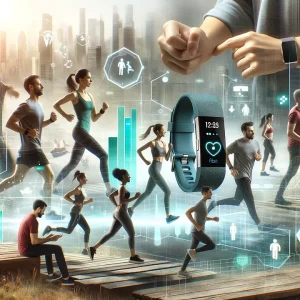The fitness technology landscape has evolved dramatically over the years, with fitness trackers and wearables emerging as essential tools for individuals aiming to improve their health and fitness. As the overall wearables market continues to expand, estimated to be worth over $15 billion worldwide, these devices have become commonplace among everyone, from ultra-marathon runners to casual gym-goers. This article will delve into the history, benefits, features, and future trends of fitness trackers and wearables, emphasizing their impact on health and fitness.
The History of Fitness Trackers and Wearables
Early Beginnings
The origins of fitness trackers date back to the 1700s, with horologist and inventor Abraham-Louis Perrelet credited with creating the first rudimentary pedometer. This device was designed to measure distance traveled on foot. American Founding Father Thomas Jefferson is also suggested to have improved upon Perrelet’s design, contributing to the evolution of step-counting devices.
The modern concept of fitness trackers emerged in 1965 with the introduction of the Manpo-kei, which translates to “10,000 steps meter.” Invented by Dr. Yoshiro Hatano, a Japanese professor at Kyushu University of Health and Welfare, this device was rooted in research on combating obesity. Dr. Hatano proposed that walking 10,000 steps provided a healthy balance of caloric intake and expenditure. To this day, many fitness trackers still use this benchmark as a goal for users.
Technological Advancements

Since the 1960s, the technology underpinning fitness tracking devices has rapidly developed. The introduction of wireless heart rate monitors in Polar watches during the 1980s marked a significant milestone. These innovations laid the groundwork for more advanced tracking features.
The Nokia 5500 Sports handset was a pioneer in the integration of fitness tracking into mobile phones, allowing users to accurately track their physical activity. Today, fitness trackers have evolved into sophisticated devices that incorporate various features, including heart rate monitoring, GPS tracking, sleep analysis, and more.
The Rise of Wearables
Today, fitness trackers are part of a broader category known as “wearables.” This umbrella term encompasses smartwatches, wearable cameras, and augmented and virtual reality headsets. While standard fitness trackers have penetrated the market, smartwatches have gained dominance, generating $9 billion in sales in 2015 alone, with the first-generation Apple Watch leading the charge.
The future of the wearables market looks promising, with projections estimating that 245 million wearable devices could be sold by 2019. It’s crucial to note that many smartwatches also function as fitness trackers, creating an overlap that enhances their appeal.
Benefits of Fitness Trackers and Wearables
1. Enhanced Motivation and Accountability
One of the most significant benefits of fitness trackers is their ability to enhance motivation and accountability. By providing users with real-time feedback on their activity levels, these devices encourage individuals to reach their fitness goals. For example, seeing how many steps one has taken throughout the day can motivate users to walk a few more steps to meet their daily targets.
2. Comprehensive Health Monitoring
Fitness trackers offer comprehensive health monitoring features, including heart rate monitoring, sleep tracking, and calorie counting. These functionalities allow users to gain insights into their overall health and fitness levels. For instance, a fitness tracker that monitors heart rate can help users identify their target heart rate zones during workouts, optimizing their training for better results.
3. Customization and Goal Setting
Fitness trackers empower users to set personalized fitness goals based on their individual needs and preferences. Users can establish goals for daily steps, exercise duration, or even weight loss. Many fitness tracking apps provide tailored workout plans and diet suggestions based on users’ progress, helping them stay on track.
4. Social Engagement and Support
Many fitness trackers come equipped with social features that allow users to connect with friends, join challenges, and share their achievements. This social engagement fosters a sense of community and support, making the fitness journey more enjoyable. For example, users can participate in step challenges with friends, promoting healthy competition and motivation.
5. Integration with Other Health Apps
Fitness trackers often integrate seamlessly with other health and fitness apps, allowing users to access a holistic view of their health data. For instance, users can sync their fitness tracker with a calorie tracking app to monitor their diet alongside their physical activity. This integration provides valuable insights and helps users make informed decisions about their health.
Examples of Popular Fitness Trackers and Wearables
1. Fitbit
Fitbit has been a pioneer in the fitness tracker market, offering a wide range of devices that cater to different needs and preferences. Models like the Fitbit Charge and Fitbit Versa provide users with features such as heart rate monitoring, sleep tracking, and GPS capabilities. Fitbit’s user-friendly app enhances the overall experience by offering personalized insights and community challenges.
2. Apple Watch
The Apple Watch combines the functionality of a smartwatch with advanced fitness tracking features. It offers heart rate monitoring, workout tracking, and even an ECG app for users to monitor their heart health. The integration of Apple Health allows users to track various health metrics, including steps taken, calories burned, and sleep patterns.
3. Garmin
Garmin is well-known for its GPS-enabled fitness trackers, making it a popular choice among athletes and outdoor enthusiasts. Models like the Garmin Forerunner series provide advanced running metrics, VO2 max estimation, and performance tracking for a variety of sports. The Garmin Connect app allows users to analyze their performance data and set training goals.
4. Polar
Polar has a long history of producing fitness tracking devices, especially for athletes. The Polar Vantage series offers advanced heart rate monitoring, training load analysis, and recovery insights. Polar’s Flow app provides users with a comprehensive overview of their training progress and allows for easy goal setting.
5. Motiv Ring
Motiv Ring is a unique entry into the wearables market, taking fitness tracking off the wrist and into a discreet ring. This sleek device tracks activity, heart rate, and sleep, providing users with essential health metrics in a stylish form factor. The Motiv app offers personalized insights and goal-setting features.
The Impact of Fitness Trackers on Weight Loss
While fitness trackers can provide valuable support in achieving health and fitness goals, their effectiveness in promoting weight loss has been a topic of debate. A study published in the Journal of the American Medical Association found that participants using fitness trackers (in this case, the Fit Core armband) were less effective at losing weight compared to those following a traditional diet and exercise plan.
Researchers suggested that individuals may become overly reliant on the device, leading to less self-motivation and a passive approach to health management. However, it’s important to note that many fitness trackers now offer companion apps that include calorie tracking, social features, and personalized exercise plans to assist users.
The Role of Personal Trainers with Fitness Wearables
As fitness trackers have become mainstream, some have speculated that they might replace traditional personal trainers. However, studies indicate that personal trainers play an essential role in achieving health and fitness goals. While fitness trackers can provide data and insights, they cannot replace the expertise and personalized guidance offered by qualified professionals.
Fitness trackers and fitness instructors can complement each other effectively. Personal trainers can help clients develop customized exercise and diet plans based on the data collected by wearables. This combination of technology and human expertise creates a holistic approach to fitness and wellness.
Future Trends in Wearable Fitness Technology
As technology continues to advance, the future of fitness trackers and wearables is promising. Several emerging trends are shaping the future of this industry:
1. Smart Jewelry for Fitness Tracking

One avenue being explored is the development of smart jewelry, taking fitness tracking off the wrist and into more discreet forms. Devices like the Motiv Ring are already paving the way for this trend, offering users a stylish alternative to traditional fitness trackers.
2. Biometric Clothing
Biometric clothing is another exciting development in the wearables market. Companies like OMsignal and Hexoskin are creating garments that monitor heart rate, breathing, and other biometric data. These innovative products allow for seamless tracking of fitness metrics without the need for bulky devices.
3. Enhanced Accuracy and Features
As competition in the wearables market increases, manufacturers are continually striving to enhance the accuracy and features of their devices. Users can expect improvements in heart rate monitoring, sleep analysis, and even advanced metrics like blood pressure readings and blood sugar level monitoring.
4. Integration with Health Care
The integration of fitness trackers with healthcare systems is on the rise. As more healthcare providers recognize the importance of patient engagement in managing chronic conditions, wearables can play a vital role in monitoring health metrics and providing valuable data to healthcare professionals.
5. AI and Machine Learning
The integration of artificial intelligence (AI) and machine learning into fitness trackers will enable more personalized experiences for users. These technologies can analyze user data, provide tailored recommendations, and even adapt fitness plans based on individual progress.
Conclusion
Fitness trackers and wearables have transformed the way individuals approach health and fitness. From their historical roots to their current capabilities, these devices offer a wealth of benefits, including enhanced motivation, comprehensive health monitoring, and personalized goal-setting. While their effectiveness in weight loss may vary, they serve as valuable tools for individuals on their fitness journeys.
As technology continues to advance, the future of fitness trackers and wearables looks bright, with emerging trends such as smart jewelry, biometric clothing, and improved accuracy. By harnessing the power of wearables, individuals can take control of their health and well-being, making informed decisions on their path to fitness.



